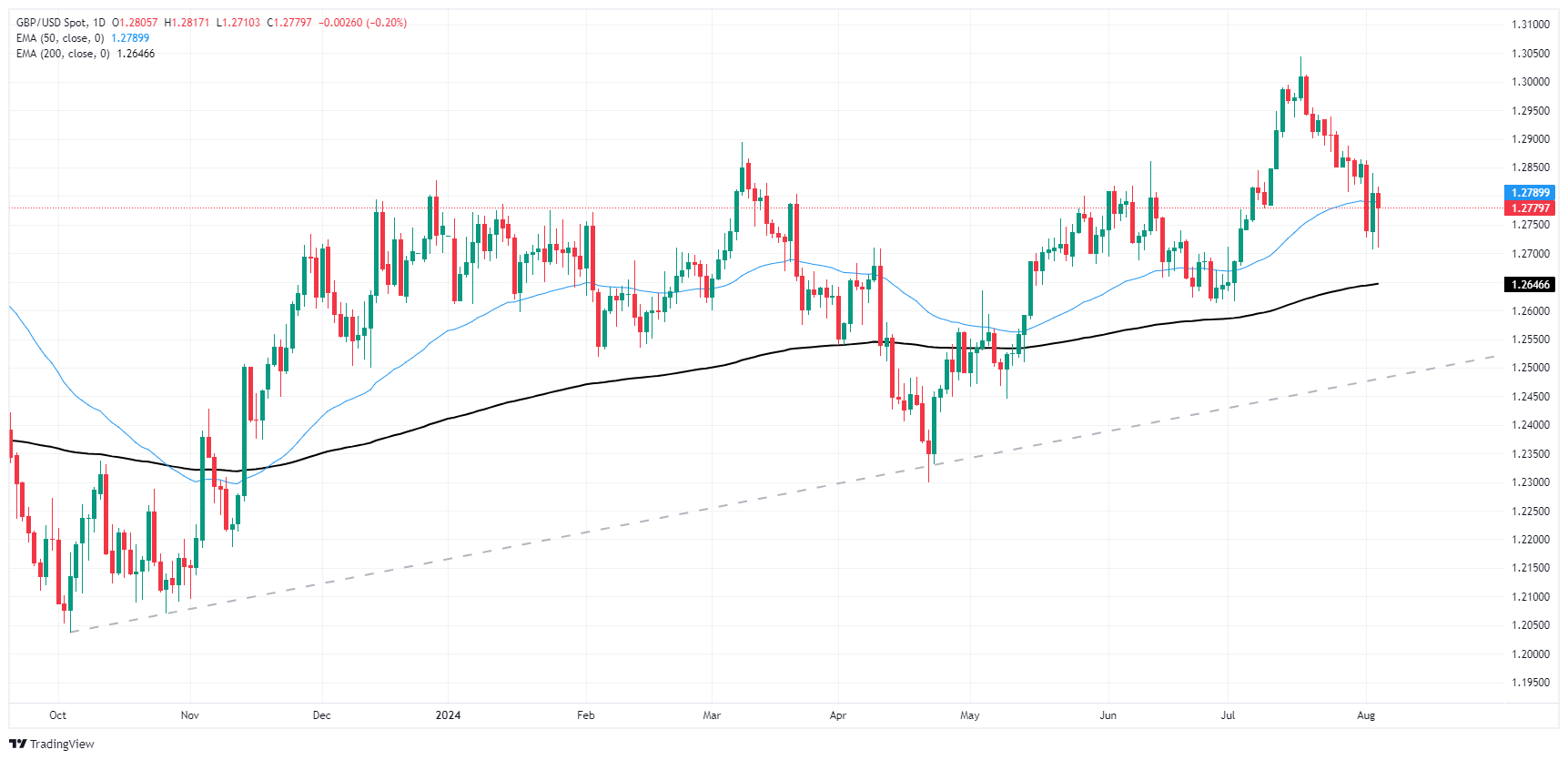GBP/USD falters on uneasy market flows but holds in midrange
- GBP/USD took a tumble on Monday after risk-off flows pummeled markets.
- Despite a near-term plunge, bids continue to grind out chart paper near 1.2800.
- Souring US economic data has markets piling into Fed rate cut bets.
GBP/USD kicked off the new trading week with a fresh plunge on Monday, falling into familiar lows just north of 1.2700 before recovering ground to end the day close to where it started just below the 1.2800 handle. Markets reversed course and piled into the Greenback in early trading after more US data came in below expectations, hardening broad-market bets of an accelerated pace of rate cuts from the Federal Reserve (Fed) through the rest of the year.
Forex Today: Fed’s rate cut gathers pace
According to the CME’s FedWatch Tool, rate markets are pricing in nearly 85% odds of a double-cut from the Fed on September 18th for 50 basis points after US data took a turn on Friday and further mixed prints on Monday. The rest of the trading week offers a light affair on the economic data docket, giving markets some breathing room and some time to chew on current positioning.
July’s US Composite Purchasing Managers Index (PMI) printed below expectations on Monday, falling to 54.3 versus the forecast flat hold at 55.0. However, ISM Services PMI for the same period accelerated to 51.4, beating the forecast 51.0 and climbing above the previous 48.8 to settle back in expansion territory above 50.0. However, the ISM Sevices Prices Paid in July accelerated to 57.0 from 56.3, routing the market’s forecast tick down to 55.8 as business-level inflation pressures continue to simmer away.
GBP/USD technical outlook
Monday’s back-and-forth chart action has left Cable battling the 50-day Exponential Moving Average (EMA) at 1.2790, with intraday price action hobbled just south of the 1.2800 price handle. Bids continue to hold on the high end of the 200-day EMA at 1.2672, but bidders are struggling to find a foothold with GBP/USD down 2.58% peak-to-trough from July’s 12-month peak at 1.3044.
GBP/USD daily chart
Pound Sterling FAQs
The Pound Sterling (GBP) is the oldest currency in the world (886 AD) and the official currency of the United Kingdom. It is the fourth most traded unit for foreign exchange (FX) in the world, accounting for 12% of all transactions, averaging $630 billion a day, according to 2022 data. Its key trading pairs are GBP/USD, aka ‘Cable’, which accounts for 11% of FX, GBP/JPY, or the ‘Dragon’ as it is known by traders (3%), and EUR/GBP (2%). The Pound Sterling is issued by the Bank of England (BoE).
The single most important factor influencing the value of the Pound Sterling is monetary policy decided by the Bank of England. The BoE bases its decisions on whether it has achieved its primary goal of “price stability” – a steady inflation rate of around 2%. Its primary tool for achieving this is the adjustment of interest rates. When inflation is too high, the BoE will try to rein it in by raising interest rates, making it more expensive for people and businesses to access credit. This is generally positive for GBP, as higher interest rates make the UK a more attractive place for global investors to park their money. When inflation falls too low it is a sign economic growth is slowing. In this scenario, the BoE will consider lowering interest rates to cheapen credit so businesses will borrow more to invest in growth-generating projects.
Data releases gauge the health of the economy and can impact the value of the Pound Sterling. Indicators such as GDP, Manufacturing and Services PMIs, and employment can all influence the direction of the GBP. A strong economy is good for Sterling. Not only does it attract more foreign investment but it may encourage the BoE to put up interest rates, which will directly strengthen GBP. Otherwise, if economic data is weak, the Pound Sterling is likely to fall.
Another significant data release for the Pound Sterling is the Trade Balance. This indicator measures the difference between what a country earns from its exports and what it spends on imports over a given period. If a country produces highly sought-after exports, its currency will benefit purely from the extra demand created from foreign buyers seeking to purchase these goods. Therefore, a positive net Trade Balance strengthens a currency and vice versa for a negative balance.